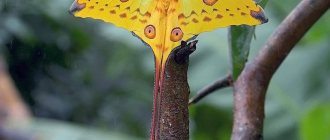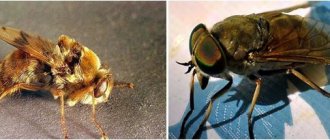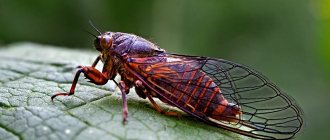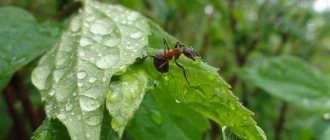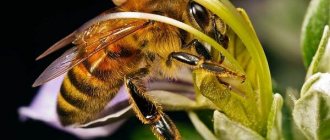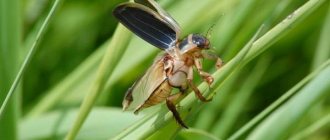- Description of the scoop butterfly
- Types of cutworms and how to distinguish them Winter cutworm
- exclamation scoop
- Cutworm
- Cabbage scoop
Cutworms are small brown butterflies that closely resemble house moths in appearance. However, despite their small size, they are the worst pests of agricultural crops. The moth moth is distributed throughout Eurasia and North Africa.
Armyworm caterpillars damage all crops from the Cabbage and Solanaceae families, as well as sunflowers, green crops, cucumbers, and ornamental flowers. Details of the description of this butterfly and measures to combat it are included in this material.
Description and features
Podalirium is an arthropod - it is a highly developed insect compared to most invertebrates. It got its name thanks to its limbs. The next distinguishing feature of this creature is its skeleton.
It is formed from durable polysaccharide platelets or quinine. The butterfly has a complex system of muscles that are attached to the integument from the inside. All movements of the body and internal organs are associated with them.
The structure of the podalirium butterfly:
- Narrow and long abdomen.
- The head is small.
- Lowered forehead.
- The eyes are large and faceted. Podalirium distinguishes moving objects well. Sees clearly up close, but also distinguishes distant silhouettes well. Color recognition occurs from 3-4 meters. Red shades cannot be seen, but are capable of perceiving the ultraviolet part of the spectrum, which is not noticed by humans. All colors for butterflies appear brighter.
- Club-shaped antennae. They are otherwise called “antennas”. Located on the parietal part of the head. This is the main sensory organ. Necessary for scent recognition and balancing during flight.
- Chest with fluff.
- Proboscis. The mouthparts are elongated, sucking type, designed to capture nectar. Formed from the lower jaw and lip.
- Front, hind and middle legs. They are needed first of all only to gain a foothold in one place, and only then for movement.
- Two pairs of wings (front - triangular, rear - oval). The wings have a self-cleaning function. They are tender and fragile. Small particles of moisture and dirt complicate and make the flight heavier. On the surface of the wings there are overlapping scales with grooves. Moisture and dirt roll down them.
This is interesting! All podalirium butterflies have a Jones organ. It acts as an analyzer of sound vibrations and shaking. With this, the butterfly's organs communicate with each other.
The internal structure of her body:
- excretory organs;
- intestines;
- goiter;
- heart;
- genitals;
- nerve ganglion;
- brain.
Such butterflies have a fully developed nervous system and sensory organs. Thanks to this, they are well oriented in nature and quickly react to danger. The nervous system consists of two parts:
- peripharyngeal ring;
- ventral nerve cord.
In the head of a butterfly, the brain is formed from the fusion of nerve cells. He is responsible for all movements. The circulatory system is of an open type. Washes all tissues and internal organs. She does not participate in breathing. To do this, tracheas are branched throughout the body of the butterfly, through which air flows.
Coloring
The butterfly has a cream or light yellow body color. The wings are marked with patterns in the form of black wedge-shaped stripes of different sizes. There is a dark border along the edge. The hind wings have arched spots of deep blue color.
Here, each individual has a dot in the form of an eye with a red frame. The color of the inside of the wings is the same as on the outside. The color of individuals may vary depending on the period of birth. Individuals born in spring have a yellow stripe on the edge of their wings. Summer insects do not have it.
How to deal with cutworms
An integrated approach should be used to combat this insidious pest. For example, you cannot rely only on commercial chemicals or folk remedies, since this may not be enough to free crops from cutworms.
Agrotechnical measures should also be practiced to curb the development of the pest. In some cases, a biological method may be effective.
All methods of struggle are divided into the following types:
- agrotechnical;
- mechanical;
- biological;
- folk remedies.
Kinds
Podalirium is a butterfly that has several varieties found in different parts of the world:
| Subspecies | Its features |
| Iphiclidens podalirius inalpina | Lives in the Alps. Features: shortened wings with a tail, wide wedge-shaped black stripes. |
| Iphiclidens podalirius eisthamelii | Lives in Spain and Portugal. Features: The front fenders are decorated with 7 vertical stripes. The underside of the wings is yellow. |
| ab. Undecimpineatus | Features: The front fenders are decorated with 6 black stripes. |
Lifestyle and habitat
Podalirium lives in different parts of the planet. You can find her:
- in North Africa;
- in the Near and Middle East;
- in Europe;
- in Scandinavia;
- on the British islands;
- in Crimea.
In one year it replaces two generations:
- the first flies from May to June;
- the second – July-August.
In the northern Alps, only one generation appears during the entire period. Peak activity of butterflies occurs in sunny weather from 12.00 to 16.00 hours. Insects love warm areas of the ground with shrubs growing in calcareous soil. And also found:
- in the clearings;
- on forest edges;
- in ravines;
- in woodlands.
Males love to circle over hilltops. You can often see podalirium in photos , as it loves flowering gardens and parks in populated areas.
Nutrition
The butterfly stops reproducing as soon as it runs out of protein. She is forced to absorb liquid food - nectar. This is the main source of nutrients. This amazing creature helps pollinate plants. Pollen from one plant sticks to its legs and body and is transferred to another.
The podalirium caterpillar prefers to eat fruit trees:
- cherry;
- plum;
- apple tree;
- rowan;
- thorn;
- peach.
Caterpillars love to nibble on the edges of leaves. Feeding usually occurs in the morning and at night. During the day she sleeps.
A mature butterfly prefers flowers:
- hawthorn;
- honeysuckle;
- cornflower;
- broom;
- rose flowers;
- curly
Reproduction and lifespan
The development of a butterfly occurs along the following life chain:
- egg;
- caterpillar;
- chrysalis;
- mature insect.
Mating and laying eggs
When the breeding season begins, male podaliriums become active. They start looking for partners. They become extremely aggressive towards other individuals. They try to drive alien males away from the chosen territory. During this period, they try to fly more often to wet soil or puddles to replenish their supply of microelements.
Mating itself can occur on the branches of bushes or simply on the ground. After fertilization has occurred, the female begins to actively look for a secluded place. She usually uses branches of rose bushes as it.
She will feed from them and will lay eggs on the back side of the leaf. The egg of the podalirium is dark green. The top may be a little red. Depending on the degree of ripening, the color changes to blue. A black drawing appears. The egg matures in 7-8 days.
Development and structure of the caterpillar
A caterpillar is a butterfly larva. Her body consists of three parts:
- abdomen;
- breast;
- head.
The head consists of 6 parts fused together. The eyes are small and simple. Gnawing type mouth. Before the caterpillar hatches, the light egg turns dark. A small larva, 3 mm long, gnaws through the shell on its own. In the first stage of life, it is black with two small green spots on its back. The body is covered with stiff bristles.
At this age stage, the podalirium already has 3 pairs of pectoral legs and 5 pairs of false abdominal legs. They end in small claws. In the second instar, the caterpillar begins to molt. The black stubble goes away. She turns green. A white stripe appears along the back. Oblique lines are formed on the sides. In the third instar, orange dots appear.
The overall development of the caterpillar from start to finish lasts up to 25 days. For each age period, 3-5 days are allocated. After the general molt takes place, the caterpillar eats its old cuticle. Before pupation, the larva reaches a length of 30-35 mm.
To protect itself, the caterpillar uses osmetry. This is a gland that is shaped like horns. Located on the front of the chest. If the caterpillar senses danger, it moves the osmeterium forward, releasing an unpleasant odor and scaring away the enemy. The green color also helps protect the caterpillar. With him she becomes invisible. The main enemies of caterpillars are:
- praying mantises;
- beetles;
- dragonflies;
- spiders;
- praying mantises;
- ants;
- wasps.
Parasites can lay their eggs in the caterpillar's body. When harmful larvae are born, they begin to eat her alive. The most dangerous enemies are wasps and tahini flies.
They lay their offspring in the caterpillar, which continues to develop and grow. It pupates, but it is not a butterfly that emerges, but an adult parasite. It is worth noting that no one attacks ripe podalirians.
Stage – pupa
Before pupating, the caterpillar stops feeding. Red-brown spots begin to appear on the back. The color of the pupa varies depending on the season:
- in summer it is green and yellow;
- in autumn – brown.
Caterpillars pupate in different places. Some do it on tree branches. Others try to hide in secluded and inconspicuous places. If an insect needs to overwinter, it will do this in the pupal phase. The lifespan of the podalirium butterfly is 2-4 weeks. During this time, she manages to mate and lay eggs for procreation.
Summer colors in the middle of winter: Daytime Butterflies. Part No. 2
But among them I did come across very rare specimens, especially for our cool climate zone.
Marigolds (also called satyrs or satyrids, Satiridae in the ancient Greek manner) include, in particular, coffee nigella or Ligeia:
Yellow-brown Krupnoglazka - the name speaks for itself, a very rare butterfly:
But the Flower Eye, or Flower Satyr, on the contrary, is a completely common species for our latitudes, and they can often be seen in flowering summer meadows:
Satyr mating process:
The Blueberry family consists of medium-sized representatives, although very bright ones. It is likely that they inspired storytellers to create images of elves.
The Argiad's bluebird with folded wings looks blue:
The upper side of the wings makes it a completely unknown color:
The Idas blueberry hurts the eye with its coloring:
The buckthorn blueberry differs from the previous two in coloring details:
And the raspberry blueberry stands out in green tones:
And the birch Zephyr - in flowers, is already closer to the genus of bright butterflies Chervontsev of the Golubyanka family. There is nothing blue left in it:
Another representative of the variegated Bluebirds is Chervonets unpaired, with even more bright red tones. The female looks like this:
And the male Chervonets gypsy is already a flash of fire among the herbs. By the way, a very rare butterfly. It differs from the Fiery Chervonets by the presence of a pair of black streaks on the front wings.
And this is what a male Fiery Chervonets looks like. On the one hand, it is difficult not to notice him, but on the other hand, not many are lucky enough to ever see him.
The female of this species, like other Chervonts, is replete with:
And the spotted Chervonets looks like this:
There are several species belonging to the Fathead Family, but only one posed for me - the fathead dash:
The Moth family is a very large family. They divided the plants (mainly trees) among themselves, and live with them in close union. Many of them got their names from their host trees.
Variegated elm moth:
The birch moth is still only a caterpillar. A typical example of mimicry: it looks like a dry stick.
The pale moth is most often attached to willows and poplars:
And the black moth prefers dry, sunny edges of forests and meadows:
The only species of moth that I have encountered is the meadowsweet moth. By the way, the butterfly is poisonous, as evidenced by its warning coloring. Birds avoid it, so moths calmly gather in large groups on open, dry landscapes, not being afraid of anything and letting them get very close.
And they fly very lazily and slowly.
And from the Belyanok family, which is supposedly the most widespread throughout the country, I only have 2 species in my collection.
This is Brukvennitsa:
And Krushinnitsa, an early spring butterfly, pollinating the first flowers of the coltsfoot.
Representative of the nocturnal fauna - the odorous woodborer or willow, a hefty gray butterfly:
And its caterpillars, up to 12 cm long (!!!), gnaw wide passages and holes in tree trunks. This specimen was taken in Finland, which indicates the high adaptability of the species to frost.
And this is a huge caterpillar of the bedstraw Hawkmoth, a large and beautiful nocturnal butterfly, which I have not yet been able to meet:
Fingerwing from the family of the same name, twilight butterfly:
Bird cherry ermine moth, its caterpillars, like any moth, lead a parasitic lifestyle, this species damages bird cherry. For a moth, it is quite large, 3 cm.
Caterpillar of the grass cocoon moth, family Cocoon moths. The adult is a large butterfly, but I don’t have any pictures of it.
I’ll take my leave, because the general mass of material on butterflies has finally run out.
Igor Teslenko February 17, 2015 at 11:18 pm
Protection of Podaliriums
At the moment, a butterfly of this species is in the Red Data Book of Russia, Ukraine and Poland. There are several reasons that led to this:
- Destruction of forests and other plantings that are habitats for butterflies.
- Treatment of gardens and park areas with insecticides.
- Burning grass on the edges and ravines where pupae can overwinter.
- Reduction of land for feeding, which is given over to arable land or construction.
All known places where the podalirium lives are under protection. Catching them is prohibited by law.
Chemicals against armyworm
In case of massive damage to crops, the most effective way to combat armyworms is the use of insecticides. Now the most popular drugs against this pest are the following:
- Karate;
- Samurai;
- Decis;
- Stefesin;
- Proteus;
- Bazudin;
- Fufanon;
- Kinmiks.
The preparation of solutions based on these purchased products must be done strictly according to the instructions and in protective equipment. Harvesting begins 20 days or more from the date of the last treatment.
Interesting Facts
From birth, butterflies are beautiful, bright and amazing. But everything was invented by nature for a reason:
- To be recognizable to each other, they have a bright color. Predators are afraid of such flowers. The garish insects may taste disgusting or be poisonous.
- The scales on the wings not only repel dirt. Their structure contains optical structures that, when interacting with ultraviolet light, give birth to new colors invisible to the human eye.
- All butterflies, including the podalirium, can find a mate over a long distance.
- Swallowtail butterflies have a great desire to procreate. Some males of this insect can fertilize the female as soon as she emerges from the pupa. Sometimes they don’t even have time to spread their wings beforehand.
- Butterfly caterpillars just seem clumsy. They have a complex muscle system that includes about 2000 species. The caterpillar breathes through special spiracles, which are located in the abdominal segments.
- Butterflies have adapted to a variety of living conditions. They even learned to predict the weather. An hour before bad weather, they look for secluded places and hide.
- The female podalirium is larger than the male. It has almost the same color as the swallowtail.
Description of the scoop butterfly
These pests belong to the insect family. The span of their brownish or brown wings can reach 5 cm, and when folded they fit tightly to the body. The life expectancy of cutworms does not reach 1 month.
Females lay 200 or more eggs on the back of the leaves, from which voracious caterpillars hatch after 1.5 weeks. Immediately from the day they are born, the caterpillars begin to intensively feed on the delicate tissues of young leaves.
The massive flight of butterflies in the Moscow region occurs in the middle of the first month of summer. In the southern regions of the Russian Federation this happens a month earlier. At the end of August, the moth moth disappears somewhere.
